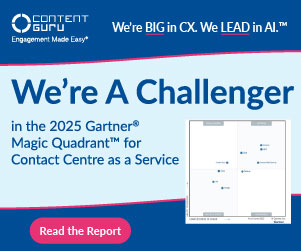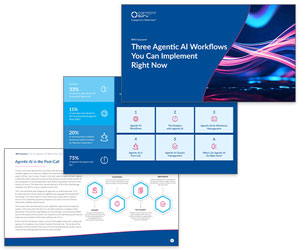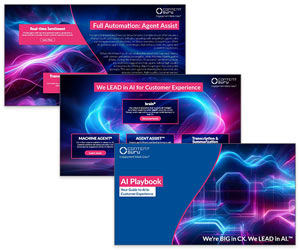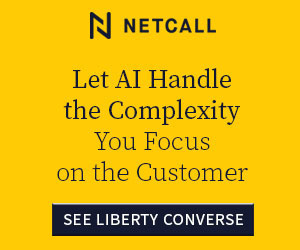Content Guru explores what it means to design ‘human-centred AI’ for customer experience and strategies for implementing human-centred AI.
Recently, Meta set out a bold new vision for its social networks. One of Meta’s AI spokespeople imagined a world in which AI-generative accounts appear alongside real users on Facebook and Instagram, posting and interacting in the same way that a human being would.
The backlash was immediate and intense. People began posting their criticisms of these AI profiles. The images the AIs posted were sloppy; they repeated facts that were untrue; in some cases, they lied to human users.
Meta quickly scrambled to delete these ‘AI character profiles’ before they could do any more reputational damage.
At the heart of all this criticism was the question, ‘What’s the point of a social network without any people?’
If AI-generated users began posting more prolifically than human users, social networks would become more like AI entertainment platforms than communication tools. People came to Meta for a social experience and they felt it was being taken away.
There are lessons here for the Customer Experience space. People value the human element, even when human outputs may be less consistent, or even of lower quality, than the AI alternative. Authenticity counts.
What is ‘Human-Centred AI’?
Human-centred AI is an AI system that works to support, rather than replace, the human element. That means making processes faster, being responsive and flexible to the needs of different users, and elevating human skills and talents.
Most AI tools designed for consumers aim to be human-centred. In the world of enterprises, though, concerns about efficiency and cost can take precedence.
In the pursuit of certain short-term KPIs, organisations often lose sight of the human element that underpins long-term success. Human-centred AI systems are built with this success in mind.
In the realm of CX, human-centered AI systems work to amplify the human aspects of customer service. Some contact center activity can be fully automated; simple and repetitive inquiries can be handled through self-service, or by conversational chatbots, reducing the burden on human agents.
Not everything can be handed off to an AI, however. As we discuss below, some situations are too complex or emotionally fraught to be trusted to an AI.
In these cases, AI can be used to enhance the agent experience, without replacing the human elements:
- Real-Time Transcription and Summarization can be used to automate post-call work. An LLM can draw out key details from an interaction transcript and populate post-interaction forms, freeing agents to move on to the next interaction.
- Real-time script suggestions can offer the agent guidance during a conversation; drawing on customer data and company knowledge articles, these hints provide a ‘next-best-action’, to help the agent create an outstanding experience.
- Sentiment analysis can detect customer sentiment during interactions, giving the agent a better perspective on how the customer is feeling, and allowing them to course-correct.
These are all examples of AI tools that serve to enhance human agents, preserving the core element of outstanding Customer Experience.
Designing Human-Centred AI for CX
Designing human-centred AI systems for your CX is simple; you just have to think in human terms. AI should operate Before, During, and After an interaction to deliver efficiencies and improve interaction quality. At every stage, AI empowers the human element, rather than replacing it.
Before an interaction, AI identifies, verifies, and routes customers to the best available outcome. This is done through Natural Language Processing and voice biometrics; customers can be identified based on their voice, after speaking a unique passphrase.
Once identified, they speak their issue out loud and are assigned a routing based on that; no need to listen to a list of pre-recorded options only to be routed to the wrong outcome.
During an interaction, real-time script suggestions guide the agent toward a speedy, successful resolution. These suggestions draw on customer data to support personalization, and change in response to the content of the conversation; meaning that they’ll always be appropriate to the topic and tone of an interaction.
After an interaction, Real-Time Transcription and Summarization work to produce an accurate transcription, which can then be subjected to AI analysis.
This analysis pulls out key details, according to a structured logic, and those details are inputted into post-call forms.
All the agent needs to do is check and approve the response, before moving on to the next interaction. In some cases, the time saved on post-call admin can add up to 33% of total Average Handling Time.
Designing human-centred AI involves thinking like a human, to automate the simplest, most repetitive tasks, whilst providing active support during more complex situations. But once you’ve designed a human-centred contact centre, you need to build it. When it comes to AI, that’s not easy.
Building a Human-Centred AI Contact Centre
The AI space moves fast. Every day, it seems like a new story rocks the AI world; from disputes between CEOs to brand-new technologies that transform the corporate pecking order.
The dust is far from settled, and every market shift has an impact on the viability of different AI providers. Tie yourself too closely to a single vendor at this stage and you could pay the price when they fall behind the competition.
Rather than an individual vendor, you need an AI partner. This partner should be able to assess best-in-class components to determine which AI models perform best for your circumstance.
They should be able to guarantee service availability and reliability, whilst preserving the integrity of your customer data. They should offer a consultative approach, identifying opportunities to deliver measurable Customer Satisfaction improvements.
Perhaps the most critical benefit of an AI partner is flexibility, and flexibility shields you from risk. If a particular model drops in performance, or a provider suffers a sudden change of fortune, the ability to switch instantly to an alternate model means that your business won’t go down with the ship.
Finding an AI partner is the most significant step your business can take toward AI transform
This blog post has been re-published by kind permission of Content Guru – View the Original Article
For more information about Content Guru - visit the Content Guru Website
Call Centre Helper is not responsible for the content of these guest blog posts. The opinions expressed in this article are those of the author, and do not necessarily reflect those of Call Centre Helper.
Author: Content Guru
Reviewed by: Rachael Trickey
Published On: 13th May 2025 - Last modified: 14th May 2025
Read more about - Guest Blogs, Content Guru






 Content Guru is the mission-critical provider of choice for large enterprises across the private and public sectors.
Content Guru is the mission-critical provider of choice for large enterprises across the private and public sectors. 

































